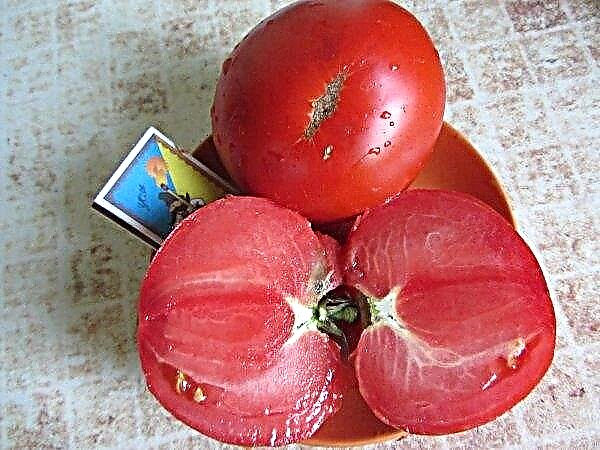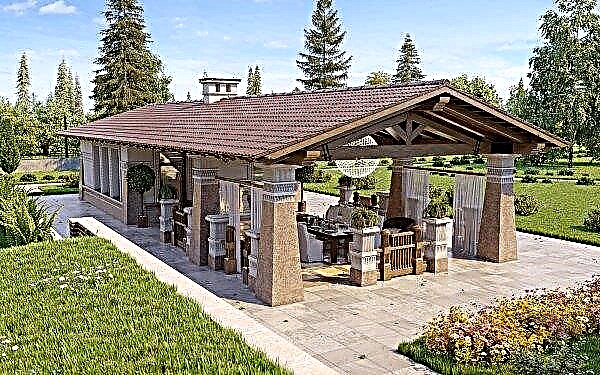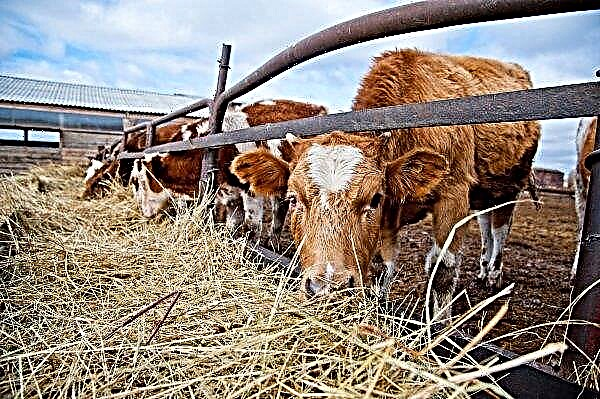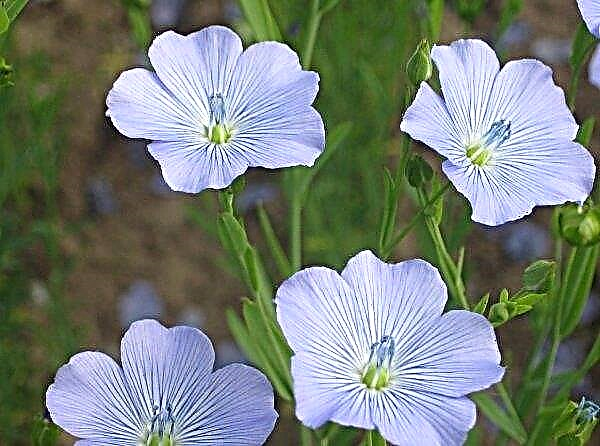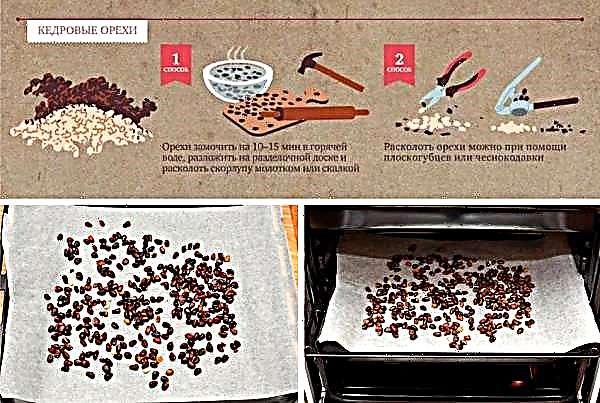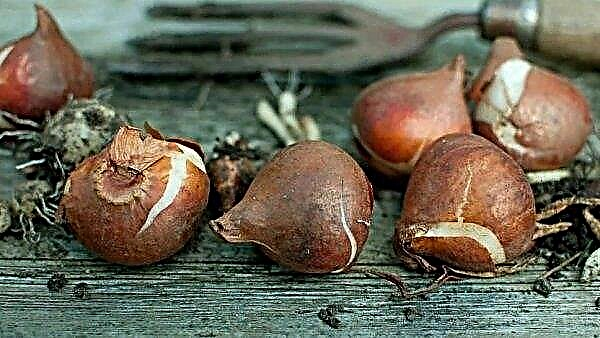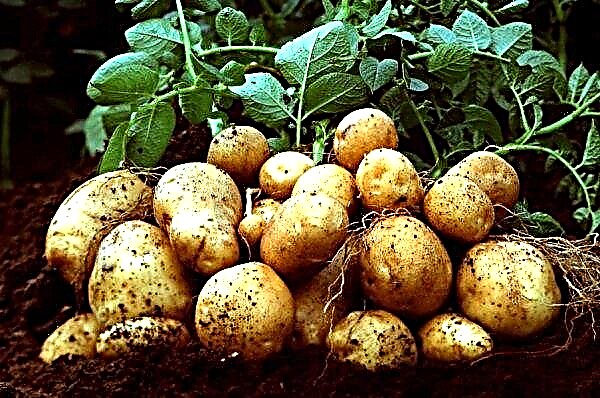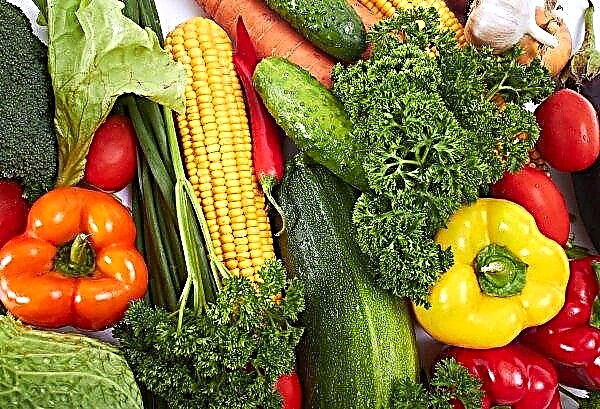Root parsley is a variety of curly parsley. Its peculiarity is that it forms root crops with a useful composition that are eaten and stored for a long time. How to plant, grow, store, consume the fruits of this subspecies - you will find the answers to these and other questions in the article.
Description and characteristics of root parsley
This plant is a biennial. It has a straight, branched stem, which reaches a height of 1 m. The leaves of the plant in the form of triangles are cirrus, dissected, and dark green in color. Their number reaches 20-30 pieces. Under the ground an elongated root crop of a creamy, white color is formed.

In shape, it somewhat resembles a carrot. In June - July, the plant produces greenish-yellow flowers. Parsley root can be cultivated in open ground, in greenhouses and hotbeds, at home on the windowsill.
Did you know? The beneficial properties of parsley have been known since ancient times. So, in ancient Rome, it was one of the ingredients of dishes that were given to gladiators before the battles: it was believed that greenery added strength and fearlessness.
Popular varieties of root parsley
In the open ground, 3 varieties are most often grown: Sugar, Alba and Harvest.
Sugar
Sugar parsley has a good yield (3 kg / m²) and delicious spicy fruits. She has large leaves - half a meter long. Root crops ripen in the early stages. Their skin is gray. The length of the root crop is 30 cm, the diameter is 6–7 cm, and the mass is 60 g.
Video: Harvesting Sugar Root Parsley
Alba
The fruits of this variety ripen at a later date. They are long, in the form of cones 20–25 cm long, 8 cm in diameter, and weighing up to 300 g. The skin color is white. Root crops are distinguished by high palatability, high yield, good keeping quality and the absence of lateral roots.

Harvest
This variety produces large root vegetables with white flesh. They reach a length of 30 cm, a diameter of 4–7 cm and a mass of 90 g. Ripen in the early medium. The yield level is 3–6 kg / m².

Growing root parsley and caring for it in the open ground
It is not difficult to grow this garden plant and take care of it. If you choose the right place for planting, plant quality material, carry out standard care procedures - watering, top dressing, loosening, weeding, preventive spraying, then parsley will delight you with quality and tasty crops.
Landing time
The best time to plant parsley in the spring is the end of April. By this time, warm air temperature should be established and the ground warm up.
Site selection and soil preparation
Root parsley needs good lighting, therefore, for its planting, you should choose a sunny area, but at the same time sheltered from cold winds. When choosing a place for the garden, you should adhere to crop rotation rules and do not plant this crop where carrots, celery, dill, coriander previously grew. Good predecessors are zucchini, cucumbers, potatoes, cabbage.

The best soil for cultivating this garden plant is loam, sandy loam, fertile. Heavy and clay soils are not suitable for him. Soil preparation should be carried out in the fall. It is cleaned of plant debris, dug to a depth of 20–25 cm and organic fertilizers are applied - 5 kg / m².
In the spring, several weeks before sowing, complex mineral fertilizers are added to such land. If the preparation was not done in the fall, then in the spring, under a digging, make 0.5 buckets of humus, 2 banks (1 liter each) of river sand, 1 tbsp. l superphosphate.
Preparing seeds for sowing
Since parsley seeds are characterized by slow germination, they must be prepared before sowing: place in warm water for 30 minutes to swell. Then they must be well dried to a loose state. If the seeds are bought from hand, then they should be pickled in potassium permanganate or in hot water (+50 ... + 52 ° C).
Seed planting technology
For sowing in the ground, grooves are made at a distance of 20 cm from each other. The embedment depth is 1–1.5 cm. For sowing 1 m², about 0.5 kg of seed material will be required. It is sown along the length of the grooves, and then sprinkled with a small layer of soil. Complete sowing must be abundantly moistened and covered with a film.
Care Features
After the shoots have sprouted, they need to be thinned out, leaving 2–3 cm gaps between them. The second thinning is done after 2 weeks. Between plants leave a distance of 6-7 cm.

Watering
The number of irrigations depends on weather conditions. In the heat you need to water often and plentifully. If the summer is rainy and cool, then watering can be done rarely. It is necessary to ensure that the upper soil layer does not dry out much. During one irrigation, approximately 20–25 l / m² should be used.
Each watering should be accompanied by loosening. The first loosening is carried out 5-6 cm in depth. In the future, the depth should be greater - 10-15 cm. These procedures avoid the formation of a hard crust on the soil surface and improve the passage of moisture and air to the roots.Important! When watering a plant, it is necessary to ensure that moisture does not get into the leaf outlet. This can trigger the development of diseases.
Fertilizer application
For parsley, you need to make 1-2 dressing per season. The first feeding is carried out when 3-4 leaves appear. At this time, ammonium nitrate (15 g / 10 l of water) is added.

The second time fertilizer is applied 20 days after the first. A mixture of ammonium nitrate (7 g), potassium salt (7 g), superphosphate (10 g) dissolved in 10 l of water is used.
Pest and Disease Control
Errors in planting and care threaten the plant with the development of diseases and attacks of harmful insects.
Of the ailments, parsley can affect such:
- Powdery mildew. With this disease, the leaves become covered with white coating, similar to flour. Its development is promoted by dampness and sharp temperature jumps. In order to prevent the disease, in the fall, after harvesting the plant debris, the soil should be treated with Bayleton.
- Alternariosis. It is characterized by damage to the root neck, stem, yellowing of the bush. Prevention of the disease is carried out by spraying “Hom” (40 g / 10 l of water), “Barrier” (1 tbsp. L / m²).
- Rust. The main symptom is rusty spots or leaves. For prophylaxis, 2 Energenom treatments are carried out (20 drops / 1 liter of water) with a break of 10 days.
- White spotting. It appears brown spots on the lower foliage, which brighten with time. To prevent disease, the seeds are treated with hot water before planting. In July, spraying with the drug "Energene" (20 drops. / 1 L of water). After 10 days, the treatment is repeated.
- Cercosporosis. The appearance of brown spots of irregular shape indicates infection. Spraying is helped with a 1% Bordeaux mixture.
Of the pests, the following are most dangerous:
- Carrot leaf-flea. It feeds on plant juices, larvae are wrapped in its leaves. To get rid of the leaf-flare, processing is required with Iskra, Fitoverm, and Karbofos.

- Stem nematode. Drinks vegetable juice, leading to yellowing of foliage, deformation of the stems and stunting. To get rid of it, apply “Karbofos”, “Phosphamide”, “Chloropicrin”, “Basamil”.

- Carrot fly. When she attacks, the foliage turns red-violet. You can scare it off if you pour sand-naphthalene mixture on the beds (10 to 1).

- Gourd aphids. It settles on the lower leaf plate to eat juices. Spraying with a soap solution (40 g of laundry soap / 10 l of water) helps to eliminate it.
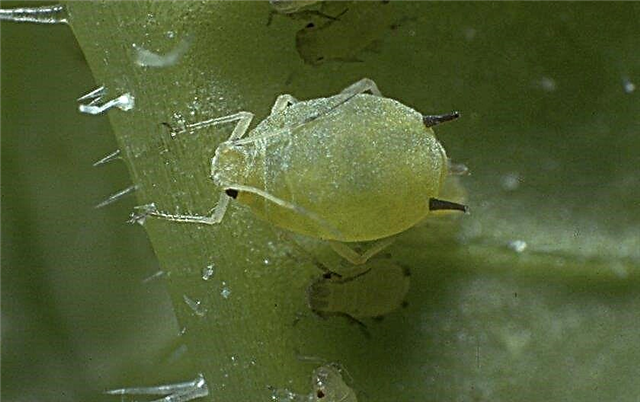
- The following measures allow to strengthen the resistance of parsley to diseases and parasites:
- Feeding with phosphorus and potash fertilizers.
- The introduction of organics only for previous cultures.
- Disinfection of seeds with hot water, in a solution of potassium permanganate (1.5%).
- Timely thinning.
- Regular loosening of the soil.
Features of planting root parsley in the winter
Since root parsley is characterized by increased frost resistance, it can be grown in the winter. In this case, the crop can be obtained 3-4 weeks earlier than when planting in the spring.
Landing time
It is better to plant a plant before the onset of cold weather - in late October - early November. When choosing a planting period, you can also focus on the weather: sowing is carried out when the air temperature drops to + 2 ° C, and the ground freezes 2 cm deep.
Important! After planting, it is necessary to mulch the bed with peat, compost and cover it with spruce branches, dry leaves. But watering during winter planting is not needed: it can harm the seeds.
Selection of suitable varieties for planting in the winter
Not all varieties tolerate cold well. The most persistent and high-yielding are the already described Sugar, Harvest and Alba, as well as Berlin, Piquant, Good morning, Eagle, Hanachka.
Harvesting and storage
Root crops are harvested in September. The procedure is planned for the day when dry and sunny weather is observed. Fruits are pulled out just like carrots - for leaves. 
After extracting them from the soil, they are dried and cut green, leaving a small stump. Only fully dried and selected fruits can be stored. The best storage method is in the cellar at a temperature of 0 ° C ... + 15 ° C, in boxes with ventilation holes covered with sand. Fruits are placed heads up. Also, parsley root can be stored in bags made of polyethylene. They need to be sprinkled with sawdust.
Root crops have found application in cooking as a seasoning and in traditional medicine as an ingredient in medicines. They are used in raw, boiled, pickled and dried form. Most often they are supplemented with fresh salads and put as seasoning for meat, fish, vegetable dishes, winter preparations.
Did you know? To stay longer young and beautiful, Empress Elizabeth washed her face with parsley infusion daily.
So, root parsley is easy to grow in a summer cottage on an open garden bed. The main thing is to choose the right place, correctly sow and carry out minimal care for the plant. Having grown a rich harvest, you can cook dishes and make winter preparations with an original taste and aroma, seasoning them with fresh or dry root vegetables.





